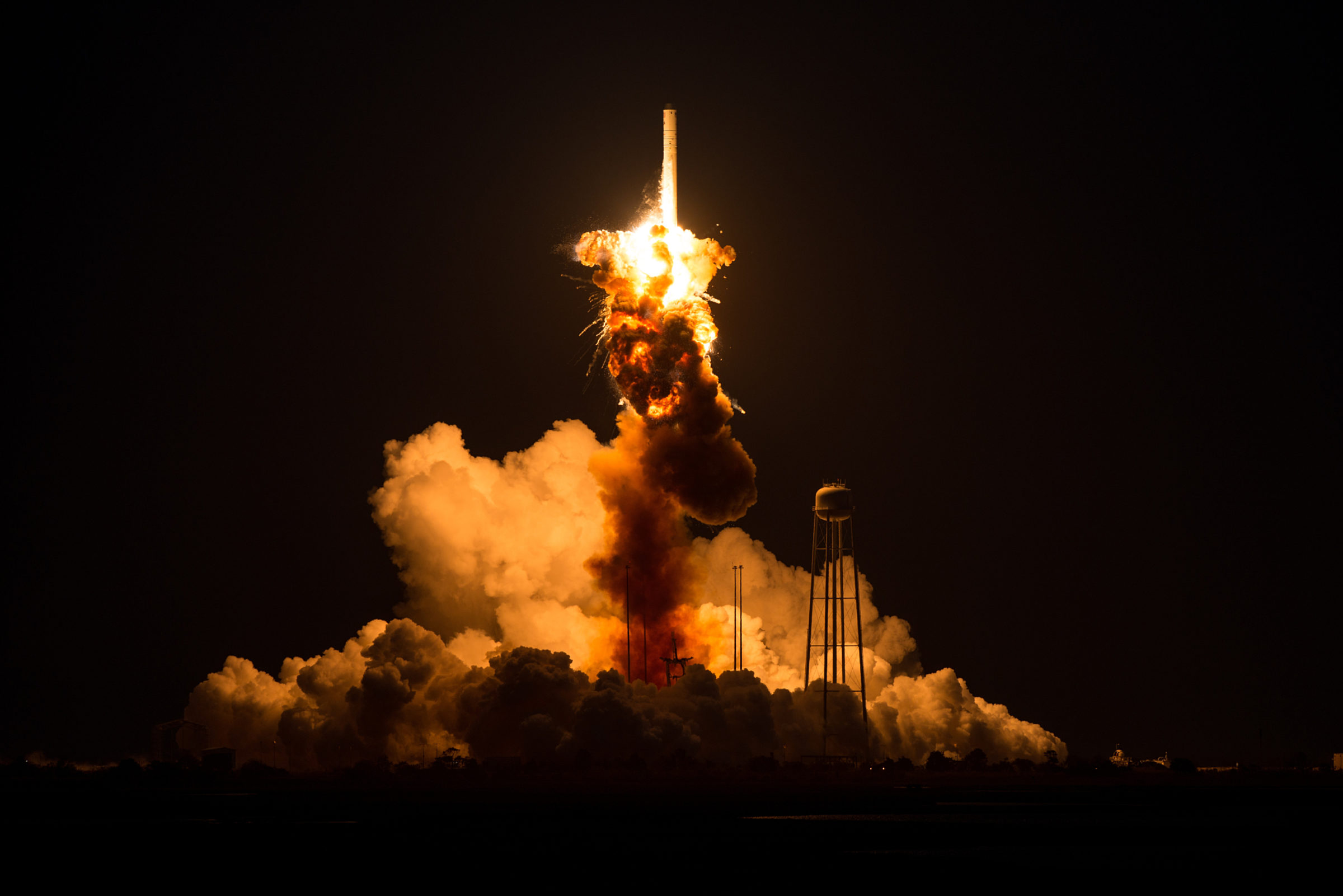Jason Davis • Oct 28, 2014
[Update 2] Antares Rocket Explodes Seconds after Liftoff
An Orbital Sciences Corporation Antares rocket fell back to the launch pad shortly after liftoff Tuesday night, exploding in a fireball that destroyed the vehicle and damaged its launch pad. The private spaceflight company confirmed all personnel were accounted for, and no one was injured in the mishap.

The rocket was carrying a Cygnus resupply spacecraft bound for the International Space Station. The cargo craft, named in honor of astronaut Deke Slayton, was loaded with almost 5,000 pounds of science investigations, crew equipment, food and vehicle hardware. The flight was Orbital’s third contracted ISS supply mission, and the fifth flight of the Antares rocket system, which had yet to experience a failure.
Liftoff occurred at 6:22 p.m. EDT from the Mid-Atlantic Regional Spaceport on Wallops Island, Virginia. Shortly after liftoff, a bright flash was seen at the base of the rocket near the engines, which resulted in debris being thrown from the vehicle. The rocket fell back to the ground and exploded, sending shards of debris flying far from the vehicle.
"What we know so far is what everybody saw in the video," said Frank Culbertson, Orbital’s executive vice president. "The ascent stopped. There was some, let’s say, disassembly, of the first stage—it looked like—and it fell to Earth."
Culbertson said the failure was observed both visually and through vehicle telemetry, adding that the range safety officer sent a self-destruct command to the rocket before it hit the ground. However, it wasn’t clear if the vehicle exploded as a result of the destruct command or actual contact with the ground.

NASA and Orbital said the majority of major damage appeared to be confined to the pad itself and the south end of Wallops Island. As of a press conference that began around 8:15 p.m., fires from the explosion were contained but still burning. Debris from the explosion was likely scattered past the shoreline. The public was urged not to handle any rocket parts—which could be toxic—and instead call 757-824-1295.
Mike Suffredini, NASA’s ISS program manager, and Bill Gerstenmaier, the associate administrator of NASA’s Human Exploration and Operations Mission Directorate, said the station crew has enough consumables to last into next year. There are two other operating station resupply vehicles: SpaceX’s Dragon capsule and Russia’s Progress vehicle. A Progress is scheduled to launch Wednesday from the Baikonur Cosmodrome in Kazakhstan.
Antares’ core stage is powered by two AJ26-62 engines, which were built in the Soviet Union during the Cold War. The engines are fed by a mixture of liquid oxygen and rocket-grade kerosene. Although an AJ26 failed during a May 2014 test firing earlier this year at NASA's Stennis Space Center, it isn’t yet clear if one of the engines doomed Antares.
The payload from the destroyed Cygnus spacecraft will be shifted to other resupply flights. Some items could also be flown on a later Cygnus mission when Antares returns to flight. In a statement, Orbital Sciences Corporation pledged to identify the cause of the failure and return its rocket to flight. NASA said that while they were disappointed in the setback, they were confident Orbital could replicate its earlier successful missions. "I think this just reminds us how difficult this business is," Gerstenmaier said.
NASA has not posted a replay of the launch, but Justin Ray (via Spaceflight Now) posted this recording to YouTube:
Update Wednesday, Oct. 29:
NASA issued a press release Wednesday evening with preliminary findings from an initial assessment of Wallops Island. So far, the list of damaged items includes the transporter erector launcher, lightning suppression rods, a sounding rocket launcher adjacent to the pad, and broken windows and imploded doors in support buildings.
The statement said initial findings show no obvious signs of air or water impact beyond the south end of Wallops Island. NASA also released this aerial photo of the site, which shows the extent of the debris field:

The Planetary Society is pleased to be a resource for journalists. Bill Nye, CEO, and Dr. Bruce Betts, director of science and technology, are available for perspective upon request. Media inquiries should be directed to Erin Greeson, [email protected], 503.913.8978.
Support our core enterprises
Your support powers our mission to explore worlds, find life, and defend Earth. You make all the difference when you make a gift. Give today!
Donate

 Explore Worlds
Explore Worlds Find Life
Find Life Defend Earth
Defend Earth

